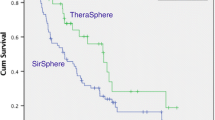Abstract
Background
Treatment with yttrium-90 (Y90) microspheres has emerged as a viable liver-directed therapy for patients with unresectable tumors and those outside transplantation criteria. A select number of patients demonstrate a favorable response and become candidates for surgical resection.
Methods
Patients who underwent selective internal radiation therapy (SIRT) with Y90 microspheres at two institutions were reviewed. Patients who underwent liver resection were included in the study. The data gathered included demographics, tumor characteristics, response to Y90, surgical details, perioperative outcomes, and survival.
Results
The inclusion criteria were met by 12 patients. The diagnoses included metastatic disease from colorectal adenocarcinoma (n = 6), neuroendocrine tumor (n = 1), and ocular melanoma (n = 1) in addition to hepatocellular carcinoma (n = 4). The median time from liver disease diagnosis to Y90 treatment was 5.5 months (range 2–92 months). The median time from Y90 treatment to surgery was 9.5 months (range 3–20 months). The surgical approach included right hepatectomy (n = 3), extended right hepatectomy (n = 5), extended left hepatectomy (n = 1), segmentectomy with ablation (n = 2), and segmentectomy with isolated liver perfusion (n = 1). The hospital stay was 7 days (range 4–31 days), and 67% of the patients were discharged home. The readmission rate was 42%. The 90-day morbidity and mortality rates were respectively 42 and 8%. At this writing, the median overall survival has not been reached at 25 months.
Conclusion
Liver resection after Y90 SIRT is a challenging surgical procedure with high rates of perioperative morbidity and hospital readmission. However, for properly selected patients, potential exists for extending disease-free and overall survival in the current era of multimodal therapy for malignant liver disease.



Similar content being viewed by others
References
Llovet JM, Ricci S, Mazzaferro V, et al. Sorafenib in advanced hepatocellular carcinoma. N Engl J Med. 2008;359:378–90.
Abou-Alfa GK, Johnson P, Knox JJ, et al. Doxorubicin plus sorafenib vs doxorubicin alone in patients with advanced hepatocellular carcinoma: a randomized trial. JAMA. 2010;304:2154–60.
Quan D, Gallinger S, Nhan C, et al. The role of liver resection for colorectal cancer metastases in an era of multimodality treatment: a systematic review. Surgery. 2012;151:860–70.
Evrard S, Rivoire M, Arnaud JP, et al. Unresectable colorectal cancer liver metastases treated by intraoperative radiofrequency ablation with or without resection. Br J Surg. 2012;99:558–65.
Cauchy F, Aussilhou B, Dokmak S, et al. Reappraisal of the risks and benefits of major liver resection in patients with initially unresectable colorectal liver metastases. Ann Surg. 2012;256:746–52.
Salem R, Lewandowski RJ, Kulik L, et al. Radioembolization results in longer time-to-progression and reduced toxicity compared with chemoembolization in patients with hepatocellular carcinoma. Gastroenterology. 2011;140:497–507.
Choi GH, Shim JH, Kim MJ, et al. Sorafenib alone versus sorafenib combined with transarterial chemoembolization for advanced-stage hepatocellular carcinoma: results of propensity score analyses. Radiology. 2013:269:603–11.
Gates VL, Atassi B, Lewandowski RJ, et al. Radioembolization with yttrium-90 microspheres: review of an emerging treatment for liver tumors. Future Oncol. 2007;3:73–81.
Salem R, Lewandowski RJ, Mulcahy MF, et al. Radioembolization for hepatocellular carcinoma using yttrium-90 microspheres: a comprehensive report of long-term outcomes. Gastroenterology. 2010;138:52–64.
Saxena A, Bester L, Shan L, et al. A systematic review on the safety and efficacy of yttrium-90 radioembolization for unresectable, chemorefractory colorectal cancer liver metastases. J Cancer Res Clin Oncol. 2014;140:537–47.
Gaba RC, Lewandowski RJ, Kulik LM, et al. Radiation lobectomy: preliminary findings of hepatic volumetric response to lobar yttrium-90 radioembolization. Ann Surg Oncol. 2009;16:1587–96.
Henry LR, Hostetter RB, Ressler B, et al. Liver resection for metastatic disease after Y90 radioembolization: a case series with long-term follow-up. Ann Surg Oncol. 2015;22:467–74.
Rayar M, Sulpice L, Edeline J, et al. Intra-arterial yttrium-90 radioembolization combined with systemic chemotherapy is a promising method for downstaging unresectable huge intrahepatic cholangiocarcinoma to surgical treatment. Ann Surg Oncol. 2015;22:3102–8.
Eisenhauer EA, Therasse P, Bogaerts J, et al. New response evaluation criteria in solid tumours: Revised RECIST guideline (version 1.1). Eur J Cancer. 2009;45:228–47.
Dindo D, Demartines N, Clavien PA. Classification of surgical complications: a new proposal with evaluation in a cohort of 6336 patients and results of a survey. Ann Surg. 2004;240:205–13.
Rahbari NN, Garden OJ, Padbury R, et al. Posthepatectomy liver failure: a definition and grading by the International Study Group of Liver Surgery (ISGLS). Surgery. 2011;149:713–24.
Wang LM, Jani AR, Hill EJ, Sharma RA. Anatomical basis and histopathological changes resulting from selective internal radiotherapy for liver metastases. J Clin Pathol. 2013;66:205–11.
Teo JY, Goh BK. Contralateral liver lobe hypertrophy after unilobar Y90 radioembolization: an alternative to portal vein embolization. World J Gastroenterol. 2015;21:3170–3.
Disclosure
The authors have no financial interests or sources of funding to disclose.
Author information
Authors and Affiliations
Corresponding author
Ethics declarations
Conflict of interest
The authors declare no conflict of interest.
Rights and permissions
About this article
Cite this article
Wright, G.P., Marsh, J.W., Varma, M.K. et al. Liver Resection After Selective Internal Radiation Therapy with Yttrium-90 is Safe and Feasible: A Bi-institutional Analysis. Ann Surg Oncol 24, 906–913 (2017). https://doi.org/10.1245/s10434-016-5697-y
Received:
Published:
Issue Date:
DOI: https://doi.org/10.1245/s10434-016-5697-y




